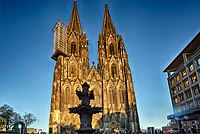
Back الرومانية الكاثوليكية في ألمانيا Arabic Església Catòlica a Alemanya Catalan Římskokatolická církev v Německu Czech Römisch-katholische Kirche in Deutschland German Iglesia católica en Alemania Spanish Église catholique en Allemagne French Katolička Crkva u Njemačkoj Croatian Gereja Katolik di Jerman ID Chiesa cattolica in Germania Italian ドイツのカトリック Japanese
Catholic Church in Germany | |
|---|---|
| German: Katholische Kirche in Deutschland | |
 | |
| Type | National polity |
| Classification | Catholic |
| Orientation | Latin |
| Scripture | Bible |
| Theology | Catholic theology |
| Polity | Episcopal |
| Governance | German Bishops' Conference |
| Pope | Francis |
| Chairman | Georg Bätzing |
| Director | Franz Lackner |
| Region | Germany |
| Language | German, Latin |
| Headquarters | Bonn, Germany |
| Members | 23.9 million (28.5%) (2022) |
| Official website | German Bishops' Conference |
The Catholic Church in Germany (German: Katholische Kirche in Deutschland) or Roman Catholic Church in Germany (German: Römisch-katholische Kirche in Deutschland) is part of the worldwide Roman Catholic Church in communion with the Pope, assisted by the Roman Curia, and with the German bishops. The current "Speaker" (i.e., Chairman) of the episcopal conference is Georg Bätzing, Bishop of the Roman Catholic Diocese of Limburg. It is divided into 27 dioceses, 7 of them with the rank of metropolitan sees.[1]
Growing rejection of the Church has had its impact in Germany; nevertheless, 28.5% of the total population remain Roman Catholic (23.9 million people as of December 2022).[2] Before the 1990 reunification of Germany by accession of the former German Democratic Republic (or East Germany), Roman Catholics were 42% of the population of West Germany.[3] Religious demographic data is relatively accessible in Germany because, by law, all Christian taxpayers must declare their religious affiliation so that the church tax can be deducted by the state and passed on to the relevant church in the state where the taxpayer lives.[4]
Apart from its demographic weight, the Catholic Church in Germany has an old religious and cultural heritage, which reaches back to both Saint Boniface, the "Apostle of Germany" and the first Archbishop of Mainz, buried in Fulda, and to Charlemagne, buried at Aachen Cathedral.
Notable religious sites include structures from the Carolingian era to modern buildings. A cursory list may name Quedlinburg, Maria Laach, Erfurt Cathedral, Eberbach, Lorsch Abbey with its remnant 'Torhalle' (gate hall), one of the oldest structures in Germany, Reichenau, Maulbronn, Weingarten, Banz and Vierzehnheiligen on the opposite hill, the Wieskirche, Ettal, Fürstenfeld, Sacred Heart in Munich (finished in 2000), Altötting and many more. Oberammergau is famous for the Passion Play staged every ten years.
The Catholic Church in Germany also boasts one of the country's most recognizable landmarks, Cologne Cathedral. Other notable Roman Catholic cathedrals are in Aachen with the throne and tomb of Charlemagne, Augsburg, Bamberg, Berlin (St. Hedwig's Cathedral) with the crypt of Bernhard Lichtenberg, Dresden, proto-Romanesque Hildesheim, Frankfurt with the coronation church of the old Reich's Emperors (superseding Aachen), Freiburg, Freising, Fulda, Limburg which was depicted on the reverse of the old 500 Deutschmark banknote, Mainz with St. Martin's Cathedral) (the only Holy see other than Rome and Jerusalem), Munich Frauenkirche with its onion domes and giant single roof, Münster, Paderborn, Passau, Regensburg, Speyer with its Rhenish Imperial cathedral, and Trier with the oldest church in the country.[5] The country has a total of about 24,500 Church buildings including many additional religious landmarks: abbeys, minsters, basilicas, pilgrimage churches, chapels, and converted former cathedrals, built in a profusion of different layouts and styles, from Romanesque to post-modern. Many are listed as World Heritage Sites.
- ^ Annuario Pontificio 2012, p. 1127
- ^ Bischofskonferenz, Deutsche (2022-06-28). "Kirchenstatistik 2022". Deutsche Bischofskonferenz. Retrieved 30 June 2023.
- ^ "Church statistics PDF" (PDF). Archived from the original (PDF) on 2010-06-02. Retrieved 2015-07-01.
- ^ Craig R. Whitney (28 December 1992). "Church tax cuts the German fold". The New York Times.
- ^ Annuario Pontificio 2008 en presentert